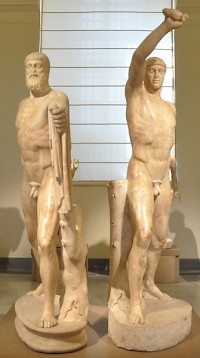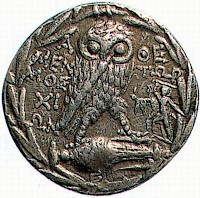Harmodius and Aristogeiton
Harmodius and Aristogeiton (†514 BCE): half-legendary tyrannicides, who killed the brother of the tyrant Hippias.

After the measures of Solon (594/593 BCE), factional strife was destabilizing Athens. The citizens accepted Pisistratus as tyrant because he promised to restore law and order. And he kept his word. His tyranny, which lasted from 546 until his death in 527, was the first period of Athenian glory. He broke the power of the old aristocracy, strengthened the institutions of the city, improved the economy, built temples, organized religious festivals, and stimulated cultural life. Had the title existed, the Athenians would certainly have called him "father of the fatherland".
Pisistratus was succeeded by his son Hippias, whose reign was resented by many people. The word "tyrant", which originally just meant "sole ruler", received its current meaning, "despot". In 514, two aristocrats, Harmodius and Aristogeiton, decided to kill the brother of the tyrant during a festival. Immediately, Hippias executed the two men.
Four years later, the Spartan king Cleomenes overthrew the tyrant and Cleisthenes introduced the democracy. The new system, which owed so much to foreigners, needed national heroes, and therefore started to celebrate the deed of the "tyrannicides", even though they had not killed a tyrant at all. (And besides, as the historian Thucydides tells us, they had killed Hippias' brother for personal reasons.)
The two men received a statue, which was well-known in Antiquity, not in the least because of its curious history. In the first place, it was the first statue for mere mortals that was erected at state expenses. It was made by a sculptor named Antenor.

But something stranger was bound to happen. In 480, the Persian king Xerxes captured Athens, and took away the statue, which was put on display in one of the capitals of the Achaemenid Empire, Susa. The Athenians of course regretted this vandalism, and ordered a copy to be made by the sculptors Critius and Nesiotes. Almost 150 years later, Alexander the Great captured Susa, and sent back the original statue. At least, that is what Arrian of Nicomedia says; Valerius Maximus tells that the group was returned by Seleucus I Nicator, the founder of the Seleucid Empire. However this may be, from then on, Athens had two sets of tyrannicides.
The group was so famous, that it was even shown on Athenian coins.